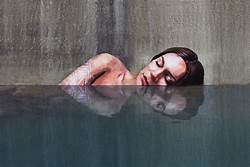-Sean Yoro, a Hawaiian born street artist, painted a mesmerizing mural at the Bay of Fundy in eastern Canada
-The mural shows a woman reaching towards the sky and is covered and uncovered every night with the changing tide
-Yoro, whose artist name is Hula, uses non-toxic paint and says the mural should last two to three months but under the right conditions could last up to two years
-It took him nine days to complete the mural and had to paint quickly and consider the tide
-It is his latest work in a series of water murals that have appeared in locations including Puglia, Italy and West Palm Beach, Florida
This
Hawaiian artist Sean Yoro likes to paint his evocative murals on precarious
surfaces: melting icebergs, the burnt bark of trees and remote waterside walls
at the mercy of rising tides, among others. The transient nature of the works,
which are destined to naturally disappeared shortly after their creation, is
used to bring attention to problems afflicting the environment. Yoro’s work is highly dedicated to
pushing the limits of art in nature and is highly engaged in raising awareness
of climate change.
He’s most commonly recognized for his murals that play with watery reflections in forgotten spaces, which he often paints while floating atop his surfboard.
But for his
latest project he's set an extraordinary challenge for himself, to paint
underwater while freediving, a form of diving that involves breath-holding and
no scuba gear.
Sean Yoro's
powerful art project called “Deep Seads” in Oahu, Hawaii is a stunning
series of three underwater murals
painted with ecologically safe materials made out of concrete and steel to
create underwater structures known as artificial reefs, were not harmful to the
environment, including the eco-friendly pigment sticks he used to paint and
designed to raise awareness around dying coral reefs.
"Raw
concrete and metal are the best for artificial reefs, because the algae can
just grow directly on it,” Yoro said. “the fish, as long as there’s holes and
stuff for them to live in, it immediately gives them new homes.” – Yoro said.
Yoro took 10 hours a day for 15 months to paint these meaningful murals, an experience that pushed him to his physical and mental limit.
The first
mural, called “Lumens,” depicts a person with closed eyes and raised hand with
a jellyfish floating by and is meant to capture the moment he discovered how
much beauty and magic the ocean holds, as well as the fragile state in which it
currently is. The second “Breath” shows a figure holding their breath
underwater. The third “Buried” shows a person’s body concealed by sand while
one eye peeks out. The murals were intended to represent impermanence, change,
and harmony with nature, and draw attention to the threats facing coral reefs.
All three murals disappeared within 14 days, consumed by algae that transformed the reefs into habitats for coral and other marine life.
In an another project called ‘What If I Fly’, Yoro headed to the Canadian Arctic Circle region, greatly affected by climate change in 2015.
He Traced
through the nearby Arctic waters on his paddleboard, Yoro maneuvered through
thousands of icebergs that had broken off a nearby glacier in search of the
right sheet of ice to begin preparing his mural. The rate of the melting ice
was a concern, as ice cracked and moved around him.
Yoro worked
several hours to complete this project. The painting depicted the Inuk woman he
had spoken with before, but as the waters rose and the ice melted, it was
quickly washed away.
 |
Though his underwater murals lives only for few days, Yoro is able to create a remarkable projection of the Inuit community while also drawing attention to the concerns about climate change. His work is applauded for evoking environmental discussion, but this venture is particularly special.
Yoro told
Global Citizen, “Growing up in Hawaii taught me the value of protecting the
environment and doing your own part in a community in order to live sustainably
off the land. It was at the same time that I bonded personally with the ocean
and spent every chance I could surfing. Both of these experiences constantly
overflow into my artwork and inspire me to create”
“I love the
fact that these murals are not only homes for animals, but they give life back
to the ocean. It almost feels like when a tree falls over and so much more life
grows from that tree. These sites can keep growing and expanding and marine
life will just take over and nature will just run its course.”
I combined
traditional Hawaiian tribal patterns with the same playful paint-like texture
to make tattoos on the figures," he added. "They represented the
unique scars from life we all have and carry with us. I wanted to show how
people interact to their scars and, more importantly, the beauty and importance
of them."
"Within a few weeks, these murals will be forever gone, but for those who find them, I hope they ignite a sense of urgency, as they represent the millions of people in need of our help who are already being affected from the rising sea levels of Climate Change."- he added.
As an artist, Yoro finds extreme weather and environments in which to create his work. He has painted on ice in the Arctic and under water. But Saint John and the Bay of Fundy was always a bucket-list item for him. Sean Yoro has been using the Fundy tides as his stepladder. When the tide is high, he paints the top of a head. When the tide is low, he paints the bottom. And those tides were his inspiration for the work as well.
Now he is joined forces with his twin brother Kapu to form Kapu collective, an initiative that combines his expertise as a painter and his brother’s abilities as a photographer.
Image Courtesy: Sean Yoro/Hula by Kapu Collective




















0 Comments